Predicting Future Revenue for a Retail Client
Part a
BIM has analysed the data of a retail client and following are some of the key factors that the customer should focus:
| Purpose of visit to store | |||||
| Frequency | Percent | Valid Percent | Cumulative Percent | ||
| Valid | Buying a gift | 7 | .5 | .5 | .5 |
| Large regular shopping visit | 246 | 18.0 | 18.0 | 18.5 | |
| Quick meal | 81 | 5.9 | 5.9 | 24.4 | |
| Topping up visit | 1034 | 75.6 | 75.6 | 100.0 | |
| Total | 1368 | 100.0 | 100.0 |
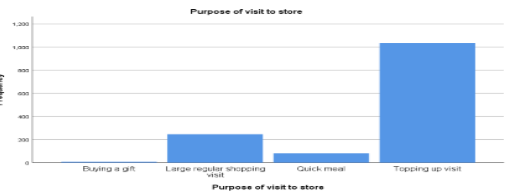
There are a greater number of customers who tend to visit the store for topping up visit and there are less number of customers with large regular visits.
Gender
| Frequency | Percent | Valid Percent | Cumulative Percent | ||
| Valid | Don’t know | 66 | 4.8 | 4.8 | 4.8 |
| Female | 796 | 58.2 | 58.2 | 63.0 | |
| Male | 506 | 37.0 | 37.0 | 100.0 | |
| Total | 1368 | 100.0 | 100.0 |
There are a greater number of females visiting the store than that of the male. This implies that there should be some offers provided for the male counterpart as well,
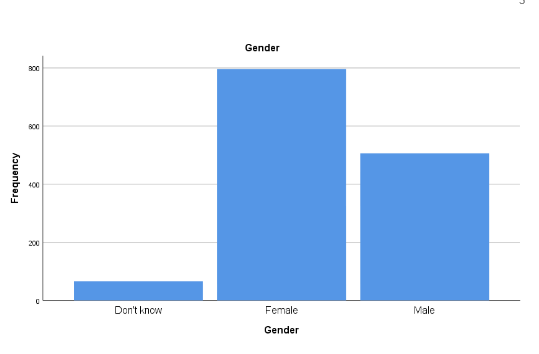
| On a scale of 0-10, please rate how likely you would be to recommend us? (0 is ‘Not likely at all’ and 10 is ‘Extremely likely’) | |||||
| Frequency | Percent | Valid Percent | Cumulative Percent | ||
| Valid | 0 | 6 | .4 | .4 | .4 |
| 1 | 2 | .1 | .1 | .6 | |
| 10 | 547 | 40.0 | 40.0 | 40.6 | |
| 2 | 7 | .5 | .5 | 41.1 | |
| 3 | 11 | .8 | .8 | 41.9 | |
| 4 | 21 | 1.5 | 1.5 | 43.4 | |
| 5 | 67 | 4.9 | 4.9 | 48.3 | |
| 6 | 58 | 4.2 | 4.2 | 52.6 | |
| 7 | 109 | 8.0 | 8.0 | 60.5 | |
| 8 | 253 | 18.5 | 18.5 | 79.0 | |
| 9 | 287 | 21.0 | 21.0 | 100.0 | |
| Total | 1368 | 100.0 | 100.0 |
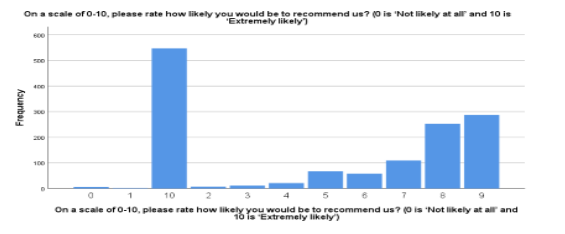
There area a greater number of consumers who are inclined to recommend about the store and that one of the important key aspect of analysing the customer response.
| Checkout option used | |||||
| Frequency | Percent | Valid Percent | Cumulative Percent | ||
| Valid | Basket checkout | 862 | 63.0 | 63.0 | 63.0 |
| Main checkout | 26 | 1.9 | 1.9 | 64.9 | |
| Self checkout | 480 | 35.1 | 35.1 | 100.0 | |
| Total | 1368 | 100.0 | 100.0 |
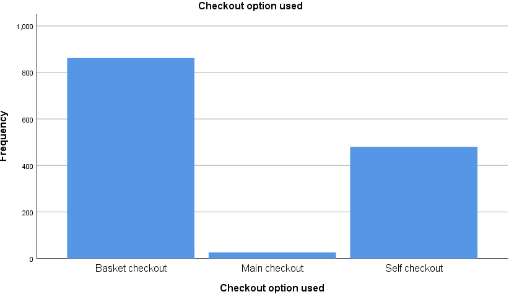
There is a more customers who are seen to prefer basket checkout over the other type of check out
| Age range (paying customer) | |||||
| Frequency | Percent | Valid Percent | Cumulative Percent | ||
| Valid | 18-29 | 11 | .8 | .8 | .8 |
| 30-39 | 132 | 9.6 | 9.6 | 10.5 | |
| 40-49 | 279 | 20.4 | 20.4 | 30.8 | |
| 50-59 | 413 | 30.2 | 30.2 | 61.0 | |
| 60-69 | 386 | 28.2 | 28.2 | 89.3 | |
| 70 plus | 112 | 8.2 | 8.2 | 97.4 | |
| Rather not say | 35 | 2.6 | 2.6 | 100.0 | |
| Total | 1368 | 100.0 | 100.0 |
The age group of 50-59 and 60-69 are considered to be the group that tend to purchase more of the products from the retail store.
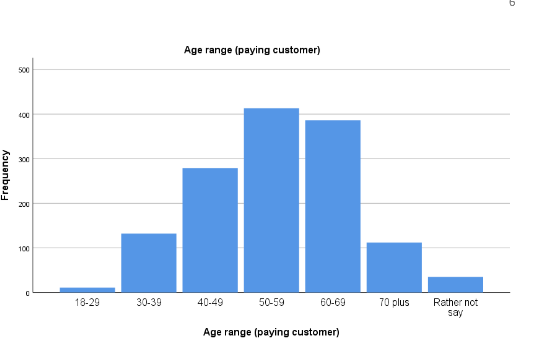
| Time of day of visit | |||||
| Frequency | Percent | Valid Percent | Cumulative Percent | ||
| Valid | Afternoon | 411 | 30.0 | 30.0 | 30.0 |
| Evening | 173 | 12.6 | 12.6 | 42.7 | |
| Lunchtime | 522 | 38.2 | 38.2 | 80.8 | |
| Morning | 262 | 19.2 | 19.2 | 100.0 | |
| Total | 1368 | 100.0 | 100.0 |

Lunchtime is considered to be ideal time for the customers to visit the store and so the company should focus on running the offers during that time for boosting the sales.
| Range of spend | |||||
| Frequency | Percent | Valid Percent | Cumulative Percent | ||
| Valid | £10 – £14 | 249 | 18.2 | 18.2 | 18.2 |
| £100 or more | 47 | 3.4 | 3.4 | 21.6 | |
| £15 – £19 | 162 | 11.8 | 11.8 | 33.5 | |
| £20 – £49 | 312 | 22.8 | 22.8 | 56.3 | |
| £5 – £9 | 218 | 15.9 | 15.9 | 72.2 | |
| £50 – £99 | 161 | 11.8 | 11.8 | 84.0 | |
| Under £5 | 219 | 16.0 | 16.0 | 100.0 | |
| Total | 1368 | 100.0 | 100.0 |
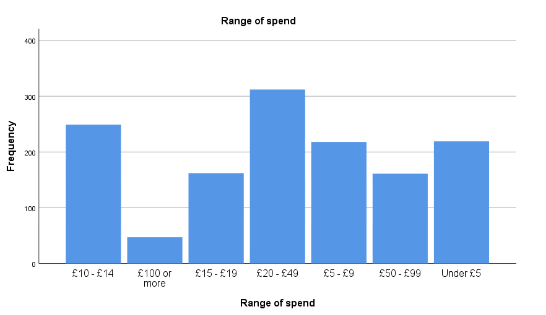
The range of spending is found to be distributed from 5 pounds to 10 pounds. So, it is important for the firm to keep products of all range.
b1 Predicting future revenue for a retail client
- Reacting and analysing revenue in future
Understanding the business problem: Forever 21 is a brick and mortar fashion accessories and apparel retailer company. The company has several stores across UK. These kinds of companies fail or succeed on the basis of how efficiently they can sell their products effectively through different revenue channels. The brand has a brick and mortar setup and generates revenue through in-store counter sales. These firms also have their resourcing and labor needs translated into projections for future revenue, such that it can assist the brand to understand whether or not they can support new technology development, professional development or added hiring with their expected revenue (Chong, 2020).
Collection of data: The first step to build a predictive analytics based model of forecasting, would entail collection of substantial data on how the company is performing at present and based on it how the company would be performing in the next 6 months. There has been a snapshot provided on the revenue in the future 6 months.
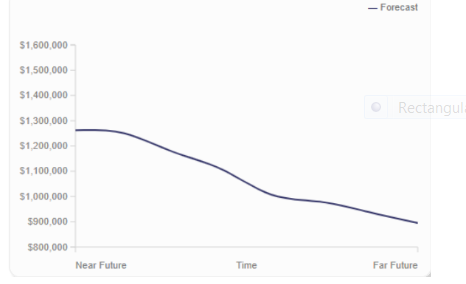
Note: It should be noted that the forecast here is based on the current in-store counter sales generation strategy that Forever 21’s retail stores in UK presently uses. The graph shows Forever 21’s declining sales in the far future.
Crunching Numbers: With the collected data, now the data can be normalized by developing several instances of actual generate revenue for the period in contrast to what the forecasted revenue for the same period was in one month or two month advance. With substantial instances on the collected data, now the average ratios can be computed of the forecasted to actual revenue for every horizon planning. This provided an average variance to the revenue predicted. Using the same data, standard deviations of that same ratio can be computed to comprehend the variation of the revenue predicted. With this, the collected data the time of the finite study period shall ensure picture of the difference between predicted revenue from that of the forecasted revenue. The below graph shows the difference between the predicted revenue and the forecasted revenue of Forever 21.
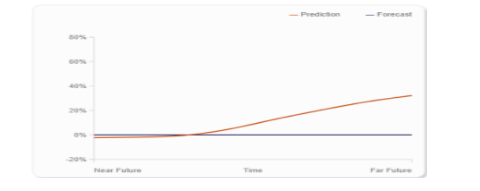
Note: It should be noted here that the predictions here are made based on the multiple channel sales strategy that BIM would recommend Forever 21 in (b) section and compared with the instore counter sales strategy that Forever 21 currently uses.
Building model: After understanding the average variation and variance over myriad horizons of planning, the standard deviation can be used for calculating the intervals of confidence at 1 and 2 σ levels in the predictions. These intervals of confidence dictated ranges which the model would expect in achieving 66% as well as 95% on the basis of historical performance (Chong, 2020).
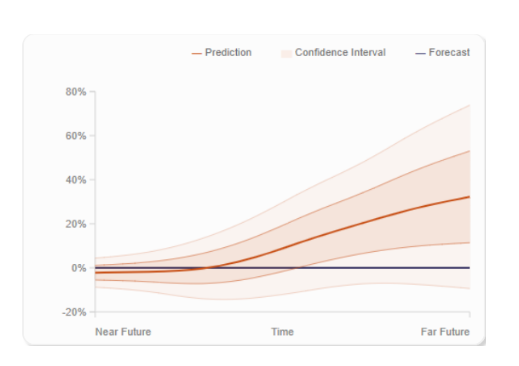
Understanding the key: The above graph shows the variance in the prediction and forecast.The differences between the prediction and forecast dictate a comparison of sales of Forever 21 between the multiple channel sales strategy (recommended by BIM) VS in-store counter sales strategy (traditionally used by Forever 21). The increasing variances of prediction show the possible higher revenue that Forever 21 can generate with BIM’s multiple channel sales strategy. The key thing to understand from here is that the future revenue of retail industry will rely on the investments that retail companies make on multiple channels of sales to generate higher revenue streams. The evolution of the retail industry from primary brick and mortar stores to online channels and more shall dictate the need of an omnipresence of revenue sources of the retail brands. Forever 21 hence must establish multiple channels to generate more revenue of its products.
- Recommendations on the new revenue streams that Forever 21 can invest on to have a multi-channel sales strategy and improve its revenue in the future:
- Adopt platforms like e-commerce and m-commerce: Since the past decade the e-commerce industry in United Kingdom has proliferated at a significant clip of 11.8% every year. It grew about 6.7% in 2019. This accounts for 7% of the overall sales in retail. With the burgeoning use of mobile devices, the penetration of smartphone in UK surpasses over 77.2% today and would grow by nearly 90% in the next 3 years (Danziger, 2020). Thus, Digital commerce will undoubtedly explode further, by making shopping activities easy within the finger-tips of consumers. For several retailers, the use of mobile platform is an important revenue channel and has been known to account for about 50% of everyday traffic and over 35% of overall sales. In the next 3-5 years, these numbers are likely to grow higher. Mobile technologies shall substantially influence every level of the journey of customer shopping. Whether it involves personalized promotions by geotargeting to price checks as well as in-store research along with improved payment capabilities which ensure options of checkout without waiting in line. A survey by McKinsey even dictates how mobile based technology can augment the experience of in-store (Nasir, 2020)
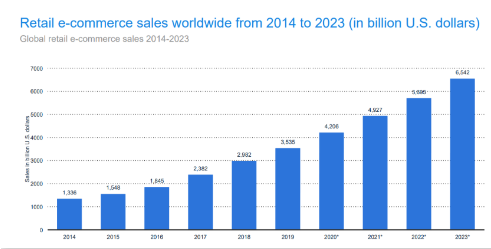
- Models of membership: These are old tactics for sports clubs, non-profits and even for retail revenue businesses. While a program of membership works for a few reasons, they many a times stem from incentives in the financial front. For several customers, they can sign a membership to business or a store, as they have a reward promised like 20% discount of the purchase. After a customer has become the store’s member, it is imperative to implement their decision with the help of emails outlined for evoking emotions. In Sephora, the program of membership enables the users to gather points post every purchase. Collecting substantial points allows one to have them exchanged for discounts or gift cards. Hence the brand of costly cosmetics enable the loyal users to get an access to special sales or even restricted collections of products. Owing to the program of points, the value of the brand stays high. The coffee shop retailer giant- Starbucks has a mobile app called My Starbucks Rewards. It is a famous app and is used globally with the caffeine addicted consumer base. The app enables the customers to have their drinks ordered in advance and pay from the device (Nasir, 2020).
- Machine learning and Artificial Intelligence: AI represents as a dominant technology since the last couple of years. After relegation to the science fiction world, AI is becoming quickly a critical and preferred tool of business. Forever 21 can utilize machine learning, data science as well as deep learning to facilitate is sales and marketing teams to comprehend the customers and automate and optimize their decisions. For example, on specific hot days, a fast food restaurant working on drive through strategy may take the decision to accentuate ice creams over any hot pies. Forever 21 can have several more opportunities for increasing revenue through AI based applications. AI can assist with a less irritating and more effective ad placement. The tailoring of the ads will be based on the erstwhile shopper’s experience. Hence, one can easily have the ads optimized for the buyer. Secondly as the algorithms start suggesting the genuinely personalized adverts, Forever 21 can ensure its customer’s shopping experience is as much seamless as plausible (Danziger, 2020).
- Virtual and Augmented Reality: Virtual and Augmented Reality have started to impact the world of retail. With technology becoming more mainstream, shoppers can enjoy a more tailored and a safer experience of shopping. While travelling through pages of online store, customers can attempt to trial a new outfit. Using the camera on mobile phones, customers of Forever 21 can see the manner in which clothes look in real life. They can rotate, check its fitting and also compare it with other clothes. The experience is likely to be similar for groceries. Several brands have begun to use the features of Augmented Reality into their brick and mortar stores (Nasir, 2020).
- Blockchain technology: Blockchain has several uses which can contribute to the future revenue in the retail industry sector. It resolves several issues by ensuring ways to manage, secure as well as centralize the data of loyalty programs. The technology of blockchain not just enables security and immediate loyalty reward point redemption instead it also streamlines the exchange and development of points across programs and retailers. With time stamped and tamper proof transaction database, retailers like Forever 21 can have tracking as well as secure loyalty program transactions in a more transparent and easier way. Crypto currency is likely to be payment form for online retailers. With payments via cryptocurrency, Forever 21 can ensure additional revenue streams and reach customers from all over the world. The technology of block-chain shall ensure Forever 21 with a greater control over how they can disseminate discounts and coupons and how these can be redeemed by customers.
b4 The long-term strategic direction of the company
SWOT analysis
| Strengths | weaknesses |
| Has a diverse set of products with main product being an online analytics dashboards Has clients from different industries including retail, hotel and IT, logistics BIM strives towards innovation and business expansion Has a large team of sales professionals Growing base of new consumers Has a greater customer demand Ability to grow and learn as a market research organization | BIM mostly use customer experience surveys and this can be a problem as the systems of scoring are influenced by motivation, personality as well as cultural trends. Thus needs of one customer would be different from another. There is a lack of accuracy of the insights extracted from customer data and this can adversely impact customer analysis The customer response nature is unstructured. This makes the data analysis more challenging A deficit of strategies to characterise consumer needs at individual customer levels There is an involvement of multiple and diverse data sets. Thus, extensive structuring of problem, parameter fitting and algorithmic training needed for getting high accuracy levels cannot be achieved in practical scenario. |
| Opportunities | Threats |
| AI or Artificial Intelligence, Big Data analytics and predictive analytics will be dominating the consumer engagement For Marketing, Block-chain technology has been gaining popularity Mobile technology with AR or Augmented Realist and VR or Virtual Reality shall ensure a new experience in the internet world (Danziger, 2020)Automation can make collection and processing of large volumes of data easier by maintaining accuracy Use of CRM tools for customer management | Highly competitive business environment with online reviews, social media and online forums rendering customers a powerful voice and making them more smarter. Customers experience a strong force with a higher bargaining power and switching costs Availability of information on product quality and services, has made customers to be more aware on product quality than ever before Rising restrictions in customer privacy regulations and security |
SMART analysis
Key strategy: To improve client experience by characterising the response of their customers at an individual level, enhancing accuracy of customer insights and fast processing of multiple data sets.
Specific: Implement Automation for faster and accurate large customer data processing. Integrate Artificial Intelligence tools for getting accurate insights on the patterns of customer behaviour and Big Data Tools, predictive analytics for tracking customer behaviour and providing real time information on the investment space in market. Lastly upgrade CRM or Customer relationship management tools for managing the different customers of industries like hotel, retail, IT, logistics etc. After implementation and integration of the tools, it is imperative to hire some data scientists and AI professionals who can engage in problem structuring. There is also a need to incorporate a training to effectively use these tools to ensure accurate reporting for better customer analysis.
Measurable: First it is important to incorporate a CRM tool and automation in the organization within the next 6 months. Then hire a data scientist to use the tools. Next, within 1 year, it is imperative to incorporate the Big Data and AI technologies. The data scientists can ensure training to the professionals to use the system properly.
Achievable: First it is critical to incorporate CRM tool and automation processes first. A performance measurement system should be setup to monitor the performances of these tools to address the core issues in customer analytics. Then, accordingly the data scientists should be hired to help the sales team appointed with the insights from Automation and CRM tools. Based on it within the next 1-year, Big Data and AI tools should be incorporated in BIM. The data scientists must train about using these systems to the sales professionals in the organization.
Relevant: Automation can ensure higher productivity by helping BIM to save time in processing multiple data sets of its client’s customers from diverse industries. Collection and data processing will become easier with Automation as there will be large data volumes to crunch. It shall also help in improving the accuracy of the processes by enhancing the speed. CRM tools will contribute towards an improved analytical data and reporting system as it shall store the data in one place and several plugin and tools can be used to generate reports automatically (Nasir, 2020). The CRM’s dashboard can also easily help to locate the information required for information of customer, the sales goals, the reports on performance for offering more opportunities. As BIM has large stretched out sales teams, the CRM can enhance efficiency by making teams be able to access the same information on the clients. By implementing CRM, the contacts of the clients of BIM can be easily managed along with the customers of their clients. Important information like the preferences, purchases can be retrieved. CRM tools will also ensure arrangement of the multiple data sets properly. Big Data can help to generate huge customer related data while AI tools like Business intelligence can assist in identifying patterns from the data quickly by focusing on the hidden insights and creating better experienced between customers to customers. Faster Live responses as well as real time collection of data shall speed up decision making and help BIM with improved customer based solutions for its clients in different industries. A critical role will be played by Data scientists as they can help to understand the customer behaviour patterns through their analysis skill sets. Training sales professionals on how to use these technologies can improve the operations in the organization and manage more new customers of BIM along with its existing ones.
Timely: The CRM tools and Automation processes will be incorporated within BIM’s operational environment in 6 months. The data scientists and AI specialized managers should be hired within 3 months. The Big Data tools and AI tools will be implemented within the next 1 year.
Action Plan
| Kinds of actions | Responsible department | Start Date | Due Date | Required Resources | Potential Blockers |
| Integration of Automation Processes | IT system development | 10.05.2020 | 10.11.2020 | Technology: Sales Force automation tools Budget: $3000/ year | Unsuccessful integration with the operational processes Data security issues Continuous system update challenges |
| Development and implementation of Cloud CRM systems ( Sales Force) | IT system development | 10.05.2020 | 10.11.2020 | Technology: Sales Force automation tools Budget: $3000/ year | Unsuccessful integration with the operational processes Data security issues Continuous system update challenges |
| Recruitment of Data scientists and AI based professionals | Human resource Management | 10.05.2020 | 10.11.2020 | Human Resource executive $60000/ year/ candidate | Lack of adequate qualified data scientists High costs of hiring data scientists |
| Implementation of Big Data analytics tools and integration with CRM | IT system development | 10.11.2020 | 10.11.2021 | Amazon Web Services. Budget: $5000/ year | Unsuccessful integration with the operational processes Data security issues Continuous system update challenges |
| Implementation of AI tools and Machine learning tools | IT system development | 10.11.2020 | 10.11.2021 | Amazon Web Services. Budget: $5000/ year | Unsuccessful integration with the operational processes Data security issues Continuous system update challenges |
| Training and education of the systems to sales professionals of BIM | IT system development and Sales and marketing department | 10.05.2020 | 10.11.2020 | Training cost: $5000/ year | Inability to adapt the training environmentPoor learning skills |
| Performance measurement of the systems (Nasir, 2020) | Operations and quality assurance | 10.05.2020 | Continuous | Use of Balanced Score Card and ISO standards and Data security standards | A slow and an inaccurate performance monitoring and constantly upgrading the processes based on the changing ISO certifications |
| Monitoring and Maintenance | Operations and Quality assurance | 10.05.2020 | Continuous | ISO standards and Data security standards | A slow and an inaccurate performance monitoring and constantly upgrading the processes based on the changing ISO certifications |
Strategic Communication: For aligning with the sales team at BIM, it is imperative to strategically enforce communication. A communication which is result driven shall focus on useful communication and deduct any kinds of additional meetings which can waste time. Each communication should be established on the basis of particular goals.
Review and monitor on a regular basis: It is critical to check in on a regular basis and ensure progress of the goals. A review done every week on the strategies, goals can assist in understanding whether any modifications are needed.
[c] Advice on a plan for a more comprehensive study of the issues facing the Business Insight Management, including project evaluation to support future decisions
Plan
Identification of key issues
The key issues facing Business Insight Management
- Inaccurate data insights: BIM assesses customer satisfaction with the help of surveys on customer experience. The key problem here is that the scoring systems being subjective are influenced by several factors like motivation, personality as well as cultural trends. Thus, the expectations of two different customers would be different from one another of what entails a specific score. This adversely impacts the accuracy of the insights. Although the data obtained is rich, however, the unstructured data of the responses of customers can be challenging.
- Lack of individual customer targeting: BIM faces a problem where the experience of individual customer levels are not characterised and focused. This also affects decision making in terms of understanding the future behaviour of these customers.
- Management of multiple data sets: As BIM has multiple data sets with diverse structures, questions and from diverse domains of business like tourism, retail, banking, logistics and entertainment, the management of multiple data sets and their analysis is an issue. It is because a lot of time gets consumed problem structuring, training of algorithms as well as parametric fitting. The slow analysis process can also slow down the decision making processes in the organization
- Client management issues: As there are increasing client requests than BIM can manage, the company is hence facing issues pertaining to management of the clients successfully. Hence it needs an improved system of managing the requests of customers efficiently.
- Lack of adequate skill sets: The client projects that BIM is presently, entails additional skill sets, for which the company does not have adequate expertise. This can be an issue as a shortage of skill set can adversely impact in competitive advantage in the long run.
Additional issues that the company is facing at present:
- Lack of predictive analysis: BIM has been facing issues with a new client in the retail industry in terms of understanding their future revenue such that they can enable improvement of operations in moving from having a reaction to past sales to managing what they can expect happening in future.
- Evaluation of online sales strategies: BIM faces issues in terms of evaluating the online business strategies of its old and prestigious clients.
- Evaluation of customer review in hotel industry for improving customer services: BIM is also presently facing issues with its abilities to evaluate customer review and offering improved customer services.
- Implementing long term strategy: BIM is presenting facing issues to create a long term strategy on how to go forward with its business processes.
- There is a problem with the performance measurement system used by BIM
- BIM also lacks foresight on the plausible adverse impacts and risk levels it can experience with its IT system’s failure.
Project Evaluation
Key Project objectives:
- To improve client experience by characterising the response of their customers at an individual level, enhancing accuracy of customer insights and fast processing of multiple data sets.
- To enhance skill set with knowledge in Artificial Intelligence, Big Data and predictive analytics and CRM
- To have an improved performance measurement system
- To implement a robust technical security control, administrative security control and physical security control
Project operations for improvement
- AI or Artificial Intelligence, Big Data analytics and predictive analytics implementation
- Automation can make collection and processing of large volumes of data easier by maintaining accuracy and Use of CRM tools for customer management
- Recruitment of data scientists to provide expertise on the industry based issues of data analytics (Nasir, 2020)
- Training of sales professionals on advanced processes of AI, Big Data analytics and CRM use in the organization
- Implementation of advanced data encryption algorithms and multifactor authentication to secure data, implement strong information security policies and ISO standards and Biometric scanning systems
Impact
The positive and the negative impacts of the above project improvement suggestions should be analyzed. On the basis of the risks in terms of time, cost and quality, the solutions which are simple should be implemented first. For example: Implementation of CRM and Automation before AI and Big Data.
Project Performance
A Balanced Score Card can be used for helping:
- BIM to clarify the strategy and communicate their business objectives and priority to employees (Key Tools and Techniques for Performance Management, 2020)
- Track Progress by measuring to what magnitude these objectives as well as priorities are delivered
- Elucidate and manage the action plans by making sure that the initiatives are placed for delivering the strategic objectives and priorities of business.
References
Chong, S., 2020. Forecasting Revenue Using Predictive Analytics For Professional Services. [online] Projector PSA Software. Available at: <https://www.projectorpsa.com/blog/forecasting-revenue-predictive-analytics-interactive-case-study> [Accessed 6 May 2020].
Danziger, P., 2020. 4 Models Of The Shopping Mall Of The Future. [online] Forbes. Available at: <https://www.forbes.com/sites/pamdanziger/2018/04/07/4-models-of-the-shopping-mall-of-the-future/> [Accessed 6 May 2020].
Bernard Marr. 2020. Key Tools And Techniques For Performance Management. [online] Available at: <https://www.bernardmarr.com/default.asp?contentID=772> [Accessed 6 May 2020].
Nasir, 2020. Objectives Of Project Evaluation. [online] Slideshare.net. Available at: <https://www.slideshare.net/RobinaNasir/objectives-of-project-evaluation> [Accessed 6 May 2020].






